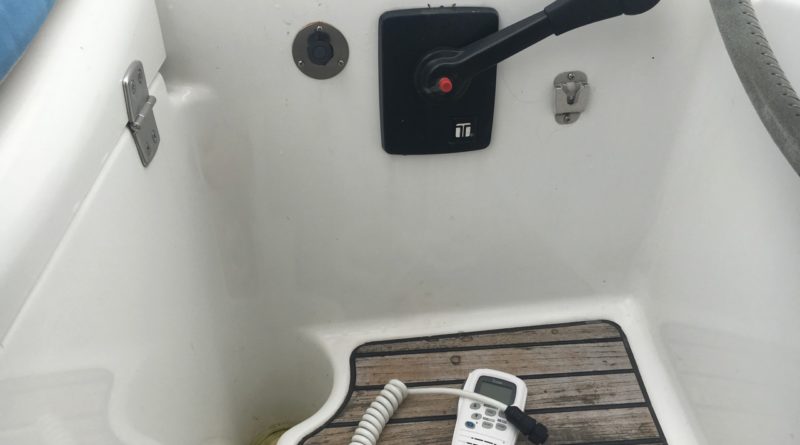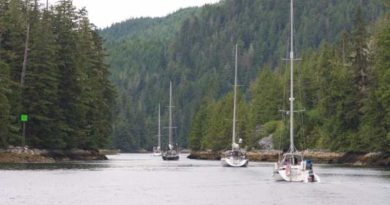Fun With Radios: Failure Edition
Sometimes it’s just time…
On Mobert, our primary VHF radio is an Icom ic-m422 Marine radio which is installed at the nav station down below. It came with the boat and it is a nice radio. In fact I bought the same exact model for our Cal 29 back in 2006, which may also tell you that our radio is, at this point, approximately 10-11 years old. In addition to the VHF unit at the nav station, we have an Icom CommandMic II installed at our port helm in the cockpit, with a cable through the boat connecting the two. This way we have access to the full power VHF from the helm, giving us much greater range than a handheld VHF radio would provide.
VHF radio operates line of sight so distance is determined primarily by the height of the antennas at both ends of the conversation and any hills or structures between. High power can help as well, but height is most important. The Icom’s 25 watts of power (vs our handheld’s 6 watts) and the >62ft foot high antenna (compared to the ~6 foot height of a handheld ) makes a significant difference in how far you can communicate.
Anyway, the radio has worked great since we bought the boat but we have had a few issues with the helm mic’s connector. The location of the connector itself is close to the port side engine control lever, so it’s easy to knock the connector when you are putting the motor in reverse. It’s also close to where the port helm seat locker lid stops when open, creating another possible way to put undue pressure on the connection. It’s obviously been an issue for a while because the connector’s plastic is cracked and missing in spots. However, the helm mic has always worked just fine.
I think I mentioned already that our VHF radio has been deteriorating while on this Alaska adventure. Primarily the speaker on the main unit seems to be blown (or the amplifier is failing) as any sound louder than a whisper causes it to garble so much we can’t understand anything that was said. This problem has been getting progressively worse.
I finally decided it needed replacement, something we will do in Anacortes before we head out to the Pacific Ocean for San Francisco, but I struggled with the decision due to the cost, but it’s a necessary piece of equipment. We toyed with just using the handheld VHF but the difference in range is so great that we really can’t rely on the handheld. There are other factors as well:
- The old radio is no longer sold, and even if there were old ones or refurbs available Icom can’t sell them because the FCC rules have changed regarding DSC (Digital Selective Calling, the distress call feature in modern VHF radios which also has some other convenience features that almost no one uses). ( I emailed Icom asking about repair/refurb/old stock and the updated FCC rules applied there too. )
- Because I can’t get the same radio I have to get a newer one, but the new radio is larger overall and requires a larger mounting hole than our existing radio (I checked multiple brands and they are all larger in general), which could mean I need to relocate some electrical panels at the nav station, or possibly reconfigure and build a whole new panel for all of the equipment. So it may not be a simple drop in.
- New radios require new mounting hardware (not included of course) so that gets added on.
- New radios require newer remote mic’s for the helm. Our CommandMic II isn’t supported by the current models made by Icom. The CommandMic IV is nicer for sure, but it adds another 50% to the cost of replacing the radio.
- Can you guess what new remote mic’s need? New (ie: different) cables to connect them of course. This doesn’t really add any cost since the cable is included, but adds significant labor/effort since I will need to pull a new 20ft cable through the boat.
I did check eBay, Craigslist, and Amazon, but didn’t have any luck, and the one that I did find said “bad speaker” so that would not have helped at all. Also, DSC enabled radios require you to program your boat’s MMSI number into them (an identification code assigned by the FCC that search and rescue databases around the world can use to figure out who you are when you hit the red distress button). The trick with buying a used radio is that you can generally only program the MMSI once or twice on a radio before it needs to be sent to the manufacturer for service to change it again. The inability to program our MMSI into a used radio was a risk I really didn’t want to take.
After discussing it amongst ourselves we went ahead and ordered the new radio and mic and mounting kit so we can get it in Anacortes and install it as quickly as we can.
Then I was looking at the manual for our VHF the other day and saw that it has a speaker output wire. So if I could get a speaker, I could just connect it and use that instead of the built-in one. And for a moment I felt like an idiot for ordering the new radio and accessories, since an external speaker would be cheaper for this otherwise working radio.
Fast forward a few days and it’s been raining, ALOT, the last couple days (Ketchikan to Prince Rupert) and the helm mic has been getting very wet. I noticed this during our stay i Ketchikan as we waited for the weather window to cross Dixon Entrance, primarily because the volume at the helm was all the way up and the audio was super quiet. I assumed that the speaker had water on it so I shook it out, blew on it, and then unhooked it to allow it to dry out down below.
We used the mic at the helm all the way to Prince Rupert (crossing Dixon Entrance) in wind/rain and it worked okay, except for the sound getting quiet periodically when it was wet. So I started bringing the mic in each night to dry out since we still had massive rain coming.
A couple of days later as we were heading south through Granville Channel, from Kumealon Inlet toward Bishop Bay Hot Springs we had a lot of strange noise on channel 16 which made it impossible to monitor 16 properly. About two hours later I finally realized it was an open mic, and my handheld was having the issue, but the primary VHF wasn’t. It turned out that our helm mic was shorted and broadcasting continuously. So I unplugged it to stop that, but it means 1.) we are now “those people” that we laugh about when the Coast Guard calls all stations asking for everyone in the area to check for an open mic.. and in fact, the day before, I heard that call from Prince Rupert Coast Guard, even saying they could hear kids in the background, and I’m now sure it was us.
All this to say that, 1.) I feel foolish for not checking for an open mic when I heard the call on the radio, 2.) I no longer feel bad about ordering all new VHF gear, and 3.) for the next two weeks we are stuck with our handheld VHF’s limited range.

Apparently, our old Icom has had enough and it’s telling us to get a new one.
After I figure out the mounting of the new radio at the nav station, the other thing I want to do is move the helm mic somewhere else. Ideally it would be at the cockpit table (in the middle of the cockpit) so it would be accessible from either helm, and more protected from rain. But it’s vastly more difficult to route a cable there so I need to do some planning first.





Hi Rich, we moved the remote Mic to under the cockpit table on our SO45 and so far pleased with it. Our set up is Raymarine, but when the mounting was at the helm We went through 3 remote mics. They just dont keep out the water ingression despite the manufacturers claims. If I don’t disconnect it and remove it when I am away from the boat, I just pop a snap and seal bag over it. So far so good.
Cheers
Steve, SV Aztec Dream
Thanks Steve! Did you do the move yourself? It seems like I can fish the wire up through the hole above the steering cable into the navpod under the table, then possibly mount the connector and the hanger right to the navpod that contains our chartplotter… Do you remember how you got the wire to the table?
Hi Rich, sorry I cheated. The Raymarine guy in Tenerife moved it for me. It sits on one of the stainless steel supports for the table right next to the Nav pod. If you want I can send a picture? As for the wiring, he managed to bring this into the Nav pod so the plug for the command mic connects to the back of the Nav pod. It also means we can both get to the remote mic as before it was at the port helm. Sorry I could not be more help. All the best. Steve
Perfect! That sounds like what I was going to attempt. Thanks!
Pingback: Prepping For Offshore Sailing – Andersons Abroad